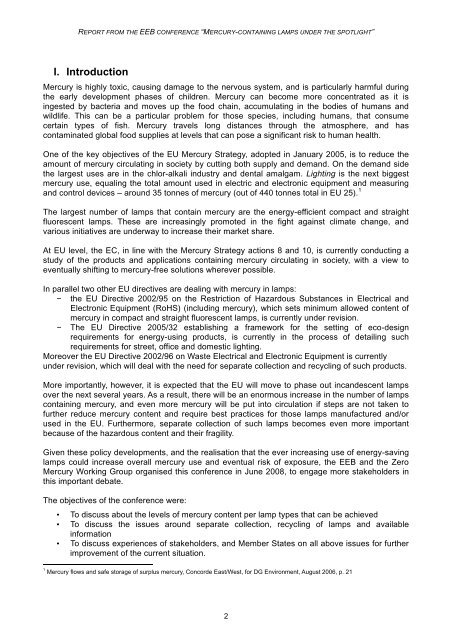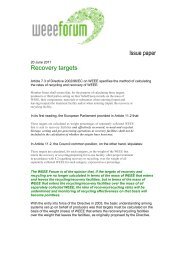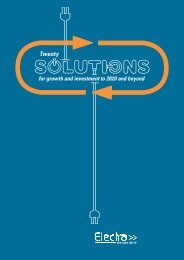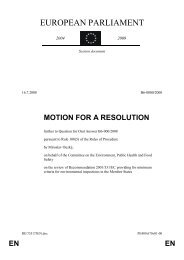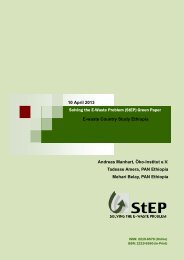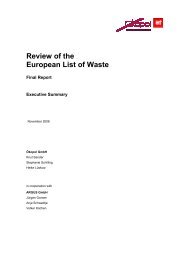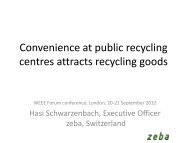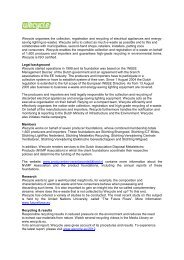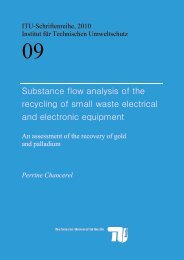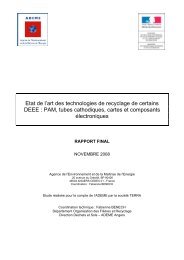Mercury containing lamps under the spotlight - WEEE Forum
Mercury containing lamps under the spotlight - WEEE Forum
Mercury containing lamps under the spotlight - WEEE Forum
Create successful ePaper yourself
Turn your PDF publications into a flip-book with our unique Google optimized e-Paper software.
REPORT FROM THE EEB CONFERENCE “MERCURY-CONTAINING LAMPS UNDER THE SPOTLIGHT”<br />
I. Introduction<br />
<strong>Mercury</strong> is highly toxic, causing damage to <strong>the</strong> nervous system, and is particularly harmful during<br />
<strong>the</strong> early development phases of children. <strong>Mercury</strong> can become more concentrated as it is<br />
ingested by bacteria and moves up <strong>the</strong> food chain, accumulating in <strong>the</strong> bodies of humans and<br />
wildlife. This can be a particular problem for those species, including humans, that consume<br />
certain types of fish. <strong>Mercury</strong> travels long distances through <strong>the</strong> atmosphere, and has<br />
contaminated global food supplies at levels that can pose a significant risk to human health.<br />
One of <strong>the</strong> key objectives of <strong>the</strong> EU <strong>Mercury</strong> Strategy, adopted in January 2005, is to reduce <strong>the</strong><br />
amount of mercury circulating in society by cutting both supply and demand. On <strong>the</strong> demand side<br />
<strong>the</strong> largest uses are in <strong>the</strong> chlor-alkali industry and dental amalgam. Lighting is <strong>the</strong> next biggest<br />
mercury use, equaling <strong>the</strong> total amount used in electric and electronic equipment and measuring<br />
and control devices – around 35 tonnes of mercury (out of 440 tonnes total in EU 25). 1<br />
The largest number of <strong>lamps</strong> that contain mercury are <strong>the</strong> energy-efficient compact and straight<br />
fluorescent <strong>lamps</strong>. These are increasingly promoted in <strong>the</strong> fight against climate change, and<br />
various initiatives are <strong>under</strong>way to increase <strong>the</strong>ir market share.<br />
At EU level, <strong>the</strong> EC, in line with <strong>the</strong> <strong>Mercury</strong> Strategy actions 8 and 10, is currently conducting a<br />
study of <strong>the</strong> products and applications <strong>containing</strong> mercury circulating in society, with a view to<br />
eventually shifting to mercury-free solutions wherever possible.<br />
In parallel two o<strong>the</strong>r EU directives are dealing with mercury in <strong>lamps</strong>:<br />
<strong>the</strong> EU Directive 2002/95 on <strong>the</strong> Restriction of Hazardous Substances in Electrical and<br />
Electronic Equipment (RoHS) (including mercury), which sets minimum allowed content of<br />
mercury in compact and straight fluorescent <strong>lamps</strong>, is currently <strong>under</strong> revision.<br />
The EU Directive 2005/32 establishing a framework for <strong>the</strong> setting of eco-design<br />
requirements for energy-using products, is currently in <strong>the</strong> process of detailing such<br />
requirements for street, office and domestic lighting.<br />
Moreover <strong>the</strong> EU Directive 2002/96 on Waste Electrical and Electronic Equipment is currently<br />
<strong>under</strong> revision, which will deal with <strong>the</strong> need for separate collection and recycling of such products.<br />
More importantly, however, it is expected that <strong>the</strong> EU will move to phase out incandescent <strong>lamps</strong><br />
over <strong>the</strong> next several years. As a result, <strong>the</strong>re will be an enormous increase in <strong>the</strong> number of <strong>lamps</strong><br />
<strong>containing</strong> mercury, and even more mercury will be put into circulation if steps are not taken to<br />
fur<strong>the</strong>r reduce mercury content and require best practices for those <strong>lamps</strong> manufactured and/or<br />
used in <strong>the</strong> EU. Fur<strong>the</strong>rmore, separate collection of such <strong>lamps</strong> becomes even more important<br />
because of <strong>the</strong> hazardous content and <strong>the</strong>ir fragility.<br />
Given <strong>the</strong>se policy developments, and <strong>the</strong> realisation that <strong>the</strong> ever increasing use of energy-saving<br />
<strong>lamps</strong> could increase overall mercury use and eventual risk of exposure, <strong>the</strong> EEB and <strong>the</strong> Zero<br />
<strong>Mercury</strong> Working Group organised this conference in June 2008, to engage more stakeholders in<br />
this important debate.<br />
The objectives of <strong>the</strong> conference were:<br />
• To discuss about <strong>the</strong> levels of mercury content per lamp types that can be achieved<br />
• To discuss <strong>the</strong> issues around separate collection, recycling of <strong>lamps</strong> and available<br />
information<br />
• To discuss experiences of stakeholders, and Member States on all above issues for fur<strong>the</strong>r<br />
improvement of <strong>the</strong> current situation.<br />
1<br />
<strong>Mercury</strong> flows and safe storage of surplus mercury, Concorde East/West, for DG Environment, August 2006, p. 21<br />
2


